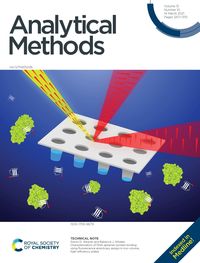

Research from the group of Rebecca Whelan, Associate Professor of Chemistry & Biochemistry, is featured on the cover of the March 14, 2021 issue of Analytical Methods. Whelan and graduate student Simon Weaver have demonstrated the use fluorescence anisotropy assays with low-volume, high-efficiency plates for aptamer-protein binding measurements.
Aptamers are important tools for measurement scientists. These short, well-defined oligonucleotides are utilized for many purposes including binding, cleaving, catalysis, and sensing. One key use of aptamers is in binding studies, where an aptamer pairs to a target compound through molecular recognition.
Traditionally, the process to find an optimized aptamer for binding with a specific target begins with the screening of a very large number of potential candidates, which is then pared down to a smaller group of functional oligonucleotides which show binding activity. Further refinement is then conducted to characterize any number of aptamer-target binding properties, such as stoichiometry, binding affinity, selectivity to the desired target, effects of pH, and limit of detection. Each of these studies can consume significant amounts of aptamer, target, or both, which can be very costly. Whelan’s work demonstrates a method to use significantly less material while still achieving accurate measurement results.
Fluorescence anisotropy (FA), which uses plane-polarized light to excite a fluorophore in the presence of the aptamer-target pair, is one of the most common analytical methods for these systems. Each experiment traditionally uses 60 µL of sample and an incubation period of 60 minutes. Whelan has shown, using the model system of thrombin with thrombin binding aptamers, that this can be reduced to a 2 µL sample size with 20 minutes of incubation with accurate results. This significant reduction in both sample size and analysis time can enable researchers to screen a greater number of aptamer candidates and can significantly lower costs.